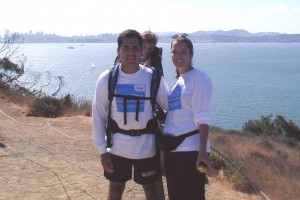Looking Back…Moving Forward: A Mom with a Mission
 As the Hydrocephalus Association continues its interview series in commemoration of their 30th anniversary, Amanda Garzon, HA’s Communications and Marketing Manager, opens up about mothering a child with hydrocephalus and shares her personal reflections on the association. Amanda’s daughter, Gabriela, was born 3 months prematurely, weighing just under 2 pounds, and acquired hydrocephalus after a grade III intraventricular brain hemorrhage (IVH). She is now 12 years old and has two VP shunts to treat her hydrocephalus.
As the Hydrocephalus Association continues its interview series in commemoration of their 30th anniversary, Amanda Garzon, HA’s Communications and Marketing Manager, opens up about mothering a child with hydrocephalus and shares her personal reflections on the association. Amanda’s daughter, Gabriela, was born 3 months prematurely, weighing just under 2 pounds, and acquired hydrocephalus after a grade III intraventricular brain hemorrhage (IVH). She is now 12 years old and has two VP shunts to treat her hydrocephalus.
HA: How did you find HA?
AMANDA: I remember hearing about HA when Gabi was still in the NICU. I wasn’t ready to talk to anyone at that point. I just wanted information. Life was moving so fast. We were so scared and were spending every day at the NICU. At that point, I was just a NICU mom, trying to get through apnea, bradychardia, feeding, retinopothy of prematurity, and Gabi’s expanding head size which they managed with a temporary reservoir and draining fluid from her brain twice a day with a needle. But I did call and talk to Pip Marks, who recommended a book HA helped author, which became my go-to book, and other information HA had available. It was so helpful to us in understanding hydrocephalus, the upcoming shunt surgery to place her permanent shunt, and what her life would be like living with hydrocephalus. But I also remember that Pip could sense that I wasn’t in a place to open up. She was so gentle with me, provided me the information, and let me know HA was there when I was ready.
HA: So when did you cross paths with HA again?
AMANDA: At the time, my family was stationed in Lemoore, CA, with the Navy. In 2002, we saw the upcoming WALK in San Francisco and decided to attend. We felt it was time to come out of our cocoon and meet other people. It was the Angel Island WALK. It was an incredibly moving experience. Pip had remembered our call! And I met her son, Sam, an incredible man.
HA: Has HA made an impact on your life? If so, how?
AMANDA: HA has touched my life in some profound ways. First, talking to Pip when we were so new to the condition gave us two critical things: 1) information; and 2) hope. Second, the educational materials have been tools I cannot live without. Every educator that has instructed Gabi has a copy of The Teacher’s Guide. Most have additional fact sheets, as well. We don’t start school without them! Third, this year’s conference in Bethesda, MD, made me feel like a kid in a candy store. There was so much information to be soaked in! It was incredible to meet doctors, other parents, and to see Gabi meeting other kids with hydrocephalus for the first time. But the highlight was meeting Jennifer Bechard. She inspired and continues to inspire me every day. She taught me so much about Gabi by sharing her own experiences of living with hydrocephalus. She talked about her challenges and for the first time I remember thinking, this is NORMAL. What Gabi is experiencing is hard, yes, but normal for a kid with hydrocephalus. And seeing what an amazing woman Jenn is, I felt peace in my heart about Gabi’s future. Many others inspired me at the conference, too, but I had a lot of heart-to-hearts with Jenn.
I guess when I look at all of my most profound experiences, I would say that what HA has given me is hope. Hope through connections to others, hope through rich detailed information, and hope through funding research that is changing the game for treating and curing hydrocephalus. HA’s impact in the research community this year alone is incredible. I encourage everyone to read back through the blogs to see all that is happening.
HA: Of all the work HA does for the hydrocephalus community, which do you find to be the most important or impactful?
AMANDA: That’s hard to answer. When I’ve taken a support call and helped someone find answers, feel more settled, and know they’re not alone…well…that’s incredibly powerful and important. The information that HA produces about hydrocephalus – from our booklets and factsheets to our blogs and articles – are CRITICAL. No one is producing consumable information for the general public and I take that mandate from our founding members and our community really seriously, as do Karima, Ashly, Jennifer, the members of the Medical Advisory Board, and our board member, Dr. Marvin Sussman, all of whom are writing and disseminating information for the public all the time.
Research, though, is what is going to provide answers.
HA: Where would you like to see HA 5 years from now?
AMANDA: HA is in the process of transitioning into its next phase as an association. We are participating more aggressively at a national level in the public health, research, and patient advocacy circles while at the same time staying true to our roots of providing services and support to our community. For the staff, it feels like a child going through growing pains. There’s a lot to do, a lot we want to do, and a small core group of us to get it done on a day-to-day basis supported by (as well as us supporting) this incredible volunteer network throughout the country, and now, Nigeria! All of us have one mission – to eliminate the challenges of hydrocephalus on all fronts from understanding it, to living with it, to treating it, and, ultimately to curing it – and we feel like a unified and determined team. It’s an incredible work environment. So 5 years from now I expect us to have come out the other end of this growth spurt standing taller. From our deep roots and the incredible foresight of our founding members, we are an established reputable presence, but in 5 years, our presence will be more widely seen and felt. Our voice will be louder.
HA: What message do you have for individuals living with hydrocephalus?
AMANDA: Hydrocephalus is a part of you but it does not define you. Live your life to the fullest, playing to all of your strengths. Understand your challenges. It will make you more insightful and also help you find ways to work with them and/or find tools to overcome some of them. As Dr. Andrew Zabel said at the conference, we’re living in an incredible technological age where there are a lot of tools that can help make your life easier. Go for it. Most importantly, learn to advocate for yourself. People won’t know what you need unless you tell them.
HA: What message do you have for the general public about hydrocephalus?
AMANDA: When I tell people where I work, I usually get a blank stare. The embarrassing question coming next of, “I’m sorry, but what IS hydrocephalus?” So much of the time people have actually heard of it. I’ll say shunt and they’ll remember that they have a neighbor with a shunt. Or I’ll say that it used to be referred to as water on the brain and they’ll say, “Oh, yeah.” In many ways, we’re invisible, though. How many times have people told me they would never know Gabi had a medical condition? If I had a nickel…haha. You don’t always “see” it but we are out there. I want the general public to know hydrocephalus. I want them to open their eyes and see that there are 1 million Americans living with a brain condition that requires BRAIN SURGERY to treat it. That is not acceptable – for my daughter or for anyone else. I am a woman on a mission to change that.
HA: What message do you have for the founding members of HA?
AMANDA: When I read through the 30 years of past newsletters, I was humbled to see all that HA has accomplished. For me, however, I am awestruck and inspired by the foresight this group of founding members had to unite patients, medical professionals, and the medical industry to work toward one cause…and that those relationships are still actively working together today. Thank you for building a foundation for HA that allows us to move the mission forward. Thank you for giving so much of yourselves to help so many of us down the road. You have touched so many lives, including that of my family. My daughter will be a stronger woman because of all that we received from HA and passed on to her. I am honored to be a part of carrying forth the mission of the association.
